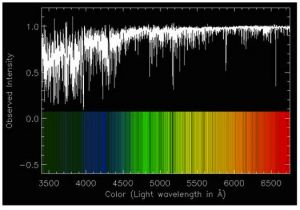 Astronomers have discovered the purest star to date. Composed almost exclusively of hydrogen and helium — with 15 million times less iron than our Sun — it illuminates what happened among the first supernovae in the early universe.
Astronomers have discovered the purest star to date. Composed almost exclusively of hydrogen and helium — with 15 million times less iron than our Sun — it illuminates what happened among the first supernovae in the early universe.
The young universe was virtually pure. Only hydrogen, helium, and a tiny trace of lithium emerged from the Big Bang nearly 13.8 billion years ago. And for hundreds of millions of years the universe was too hot to handle anything else.
But over time the universe cooled and giant clouds of the primordial elements collapsed to form the first stars. Without traces of heavier elements available to cool the gas clouds, the first “Population III” stars were extremely massive and bright, erupting as supernovae after relatively short lifetimes of just a few million years. These explosions, in turn, began seeding the young universe with heavier elements.

